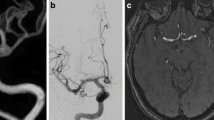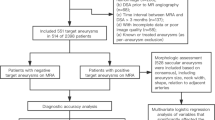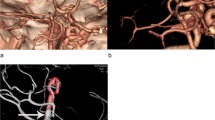Abstract
Background
The aim of our study was to evaluate the diagnostic efficacy of multislice computed tomographic angiography (MSCTA) regarding exclusion quality after aneurysm clipping.
Methods
Sixty patients (74 aneurysms) underwent microsurgical exclusion using titanium clips. The presence of aneurysm remnants on MSCTA was compared by a neuroradiologist to 2D digital subtraction angiography (DSA), which was considered as a reference examination. The contribution of 3D DSA was assessed in a subpopulation of 29 patients (35 aneurysms).
Results
With 2D DSA, six aneurysm remnants (8%) were diagnosed, and only five (7%) by MSCTA. The specificity and sensitivity were 98.5 and 83%, respectively. MSCTA failed to demonstrate one large remnant (>2 mm) because of clip artifacts (six clips). With 3D DSA six supplementary remnants were diagnosed. Two were large remnants blinded by vessel overlaps and clip artifacts. Four were small “dog-eared” remnants (≤2 mm). No additional treatment was required for small remnants.
Conclusion
In the postoperative period, MSCTA was considered a useful tool to evaluate the large remnants as well as a non-invasive ulterior examination for suspected bifurcation. Nevertheless, 3D DSA is still required for an accurate evaluation of aneurysms treated by more than three clips.



Similar content being viewed by others
References
Acevedo JC, Turjman F, Sindou M (1997) Postoperative arteriography in surgery for intracranial aneurysm. Prospective study in a consecutive series of 267 operated aneurysms. Neurochirurgie 43:275–284
David CA, Vishteh AG, Spetzler RF, Lemole M, Lawton MT, Partovi S (1999) Late angiographic follow-up review of surgically treated aneurysms. J Neurosurg 91:396–401
Dehdashti AR, Binaghi S, Uske A, Regli L (2006) Comparison of multislice computerized tomography angiography and digital subtraction angiography in the postoperative evaluation of patients with clipped aneurysms. J Neurosurg 104:395–403
Feuerberg I, Lindquist C, Lindqvist M, Steiner L (1987) Natural history of postoperative aneurysm rests. J Neurosurg 66:30–34
Fisher CM, Kistler JP, Davis JM (1980) Relation of cerebral vasospasm to subarachnoid hemorrhage visualized by computerized tomographic scanning. Neurosurgery 6:1–9
Heiserman JE, Dean BL, Hodak JA, Flom RA, Bird CR, Drayer BP, Fram EK (1994) Neurologic complications of cerebral angiography. AJNR Am J Neuroradiol 15:1401–1407 discussion 1408-1411
Holmin S, Krings T, Ozanne A, Alt JP, Claes A, Zhao W, Alvarez H, Rodesch G, Lasjaunias P (2008) Intradural saccular aneurysms treated by Guglielmi detachable bare coils at a single institution between 1993 and 2005: clinical long-term follow-up for a total of 1,810 patient-years in relation to morphological treatment results. Stroke 39:2288–2297
Kang HS, Han MH, Kwon BJ, Jung SI, Oh CW, Han DH, Chang KH (2004) Postoperative 3D angiography in intracranial aneurysms. AJNR Am J Neuroradiol 25:1463–1469
Kaufmann TJ, Huston J 3rd, Mandrekar JN, Schleck CD, Thielen KR, Kallmes DF (2007) Complications of diagnostic cerebral angiography: evaluation of 19, 826 consecutive patients. Radiology 243:812–819
Kivisaari RP, Porras M, Ohman J, Siironen J, Ishii K, Hernesniemi J (2004) Routine cerebral angiography after surgery for saccular aneurysms: is it worth it? Neurosurgery 55:1015–1024
Le Roux PD, Elliott JP, Eskridge JM, Cohen W, Winn HR (1998) Risks and benefits of diagnostic angiography after aneurysm surgery: a retrospective analysis of 597 studies. Neurosurgery 42:1248–1254 discussion 1254-1245
Lee JH, Kim SJ, Cha J, Kim HJ, Lee DH, Choi CG, Lee HK, Suh DC, Ahn JS (2005) Postoperative multidetector computed tomography angiography after aneurysm clipping: comparison with digital subtraction angiography. J Comput Assist Tomogr 29:20–25
Leffers AM, Wagner A (2000) Neurologic complications of cerebral angiography. A retrospective study of complication rate and patient risk factors. Acta Radiol 41:204–210
Macdonald RL, Wallace MC, Kestle JR (1993) Role of angiography following aneurysm surgery. J Neurosurg 79:826–832
Molyneux AJ, Kerr RS, Yu LM, Clarke M, Sneade M, Yarnold JA, Sandercock P (2005) International subarachnoid aneurysm trial (ISAT) of neurosurgical clipping versus endovascular coiling in 2,143 patients with ruptured intracranial aneurysms: a randomised comparison of effects on survival, dependency, seizures, rebleeding, subgroups, and aneurysm occlusion. Lancet 366:809–817
Proust F, Debono B, Hannequin D, Gerardin E, Clavier E, Langlois O, Freger P (2003) Treatment of anterior communicating artery aneurysms: complementary aspects of microsurgical and endovascular procedures. J Neurosurg 99:3–14
Raymond J, Guilbert F, Weill A, Georganos SA, Juravsky L, Lambert A, Lamoureux J, Chagnon M, Roy D (2003) Long-term angiographic recurrences after selective endovascular treatment of aneurysms with detachable coils. Stroke 34:1398–1403
Sagara Y, Kiyosue H, Hori Y, Sainoo M, Nagatomi H, Mori H (2005) Limitations of three-dimensional reconstructed computerized tomography angiography after clip placement for intracranial aneurysms. J Neurosurg 103:656–661
Sakuma I, Tomura N, Kinouchi H, Takahashi S, Otani T, Watarai J, Mizoi K (2006) Postoperative three-dimensional CT angiography after cerebral aneurysm clipping with titanium clips: detection with single detector CT. Comparison with intra-arterial digital subtraction angiography. Clin Radiol 61:505–512
Teasdale GM, Drake CG, Hunt W, Kassell N, Sano K, Pertuiset B, De Villiers JC (1988) A universal subarachnoid hemorrhage scale: report of a committee of the World Federation of Neurosurgical Societies. J Neurol Neurosurg Psychiatry 51:1457
Teksam M, McKinney A, Cakir B (2004) Multi-slice computed tomography angiography in the detection of residual or recurrent cerebral aneurysms after surgical clipping. Acta Radiol 45:571–576
van der Schaaf I, van Leeuwen M, Vlassenbroek A, Velthuis B (2006) Minimizing clip artifacts in multi CT angiography of clipped patients. AJNR Am J Neuroradiol 27:60–66
van Loon JJ, Yousry TA, Fink U, Seelos KC, Reulen HJ, Steiger HJ (1997) Postoperative spiral computed tomography and magnetic resonance angiography after aneurysm clipping with titanium clips. Neurosurgery 41:851–856 discussion 856-857
Watanabe Y, Kashiwagi N, Yamada N, Higashi M, Fukuda T, Morikawa S, Onishi Y, Iihara K, Miyamoto S, Naito H (2008) Subtraction 3D CT angiography with the orbital synchronized helical scan technique for the evaluation of postoperative cerebral aneurysms treated with cobalt-alloy clips. AJNR Am J Neuroradiol 29:1071–1075
White PM, Wardlaw JM, Lindsay KW, Sloss S, Patel DK, Teasdale EM (2003) The non-invasive detection of intracranial aneurysms: are neuroradiologists any better than other observers? Eur Radiol 13:389–396
Acknowledgement
The authors are grateful to Richard Medeiros, Rouen University Hospital, Medical Editor, for editing the manuscript.
The authors confirm that there is no conflict of interest concerning the materials or methods used in this study or the findings specified in this paper.
Author information
Authors and Affiliations
Corresponding author
Additional information
Comments
Digital subtraction angiography (2D or even better 3D) is still the most reliable method to evaluate patients postoperatively for possible aneurysm remnants. However, DSA as an invasive procedure has an inherent morbidity and mortality rate. Thus, the advent of less invasive procedures (CT or MR angiography) should reduce these procedure-related risks; however, an exact analysis of the pros and cons of every new follow-up regimen has to be performed. The present paper provides useful information about the comparison of MSCTA and 2D DSA (and in a subpopulation also 3D DSA), even though there are also other recently published papers reporting similar results (e.g., 1-3). Further, the present paper has significant methodological weaknesses, which have to be considered in the interpretation of the results presented: This is not a prospective study, the patients included do not represent a consecutive series, the time between surgery and postoperative DSA was variable as was the time between DSA and MSCTA, and 3D DSA was performed only in a subpopulation and not in all patients. However, on the other hand one has to consider that it would be very difficult to perform a high-level prospective, randomized, controlled study about this topic—especially when taking the problem of radiation exposure into account.
1. Chen W, Yang Y, Qiu J, Peng Y, Xing W (2008) Sixteen-row multislice computerized tomography angiography in the postoperative evaluation of patients with intracranial aneurysms. Br J Neurosurg 22: 63-70
2. Dehdashti AR, Binaghi S, Uske A, Regli L (2006) Comparison of multislice computerized tomography angiography and digital subtraction angiography in the postoperative evaluation of patients with clipped aneurysms. J Neurosurg 104: 395-403
3) Uysal E, Ozel A, Erturk SM, Kidar Ö, Basak M (2009) Comparison of multislice computed tomography angiography and digital subtraction angiography in the detection of residual or recurrent aneurysm after surgical clipping with titanium clips. Acta Neurochir (Wien) 151: 131-135
Marcus Reinges
Aachen, Germany
Rights and permissions
About this article
Cite this article
Gerardin, E., Tollard, E., Derrey, S. et al. Usefulness of multislice computerized tomographic angiography in the postoperative evaluation of patients with clipped aneurysms. Acta Neurochir 152, 793–802 (2010). https://doi.org/10.1007/s00701-009-0465-4
Received:
Accepted:
Published:
Issue Date:
DOI: https://doi.org/10.1007/s00701-009-0465-4




